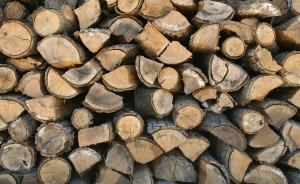 Are you ready for next winter’s cold weather? Get a head start by splitting and storing some wood. Properly cut and stacked, this wood should be fully seasoned by the time you need to start up your fireplace.
Are you ready for next winter’s cold weather? Get a head start by splitting and storing some wood. Properly cut and stacked, this wood should be fully seasoned by the time you need to start up your fireplace.
Understanding Firewood Measurements
Firewood uses measurements that you normally come across with any other material. Typically, it’s stored and sold in two sizes: cords and ricks. A cord is 128 cubic feet, and is usually measured out as 8 feet long, four feet high and four feet deep. When looking at a rick or face cord, sizes will vary. There is no official measurement, but a rick or face cord is about a third of a cord.
Preparing Your Chainsaw
The 511 and 552 both have automatic oiling systems, but they also have manual chain tensioners that should be checked before operation. Fresh fuel is critical to the operation of a 2-stroke engine: save yourself from having starting problems by buying new gasoline and mixing in the correct amount of oil along with the fuel stabilizer.
The inertia chain brake will shut down the chainsaw in case of kickback and the handles absorb most of the vibration, but you should still wear protective gear to prevent injury from sawdust and splinters coming off the blades.
Cutting Logs
Cut firewood at least 6 months before you’ll need to burn it, to allow maximum drying time.
Cut the ends of the logs as flat and square as possible. This helps them stand steady for splitting.
When removing branches, cut them the opposite direction they are pointing. This provides a smoother surface for easier stacking.
The shorter the log, the easier it will be to split. After all, if you’re going to be splitting the logs by hand, why not let the chainsaw do some of the work for you? The standard length for firewood is 16 inches, but you can go even shorter if you need to.
Splitting
To swing an ax, you need plenty of space and good footing. The block that the wood will rest on should be no higher than your knee to give you the best range of motion. When swinging, you should have as much distance between you and the log as possible, so if you miss, you’re more likely to hit the block. Splitting wood in cold weather will help get a cleaner cut.
Stacking
Curing wood is all about removing moisture. The area where the wood will be stored should be both directly and indirectly protected from the rain. That means making sure raindrops can’t hit the wood, while elevating the wood to reduce contact with water that collects on the ground. The easiest option is simply a pre-built rack covered with a tarp, although a couple boards of pre-treated wood or some pallets under a carport or canopy will work, too.
The wood should be stacked in a way that leaves plenty of open space around each log for air to pass through. This lets the air draw away the remaining water inside the log. The wood can be stacked in straight rows, rows with layers in alternating directions, or even in circular layers. Whichever method you choose, the wood should be stable enough so that the pile won’t come apart as the logs shrink with aging. The bark acts as a moisture barrier, so it can be positioned upwards to deflect rain or downwards to deflect ground moisture.
Curing
Freshly cut wood is about 50% water, but by the time it is properly cured, the water content falls to around 20%. Cured wood will look gray and form small cracks on the surface. It even sounds different, making a higher tone when struck than a new log. Properly stacked, the wood should be ready to be used in a fireplace after about 6 months.
Where to Get Parts for Your Cub Cadet Chainsaw
www.cubparts.com is more than just an online warehouse, we’re a certified Cub Cadet dealer with the same factory training and OEM parts in stock as a brick and mortar dealer. We carry everything you need to get your chainsaw ready this season including chains, bars, and other components, and we can ship these parts to any location in the U.S. and Canada.
